MGMT803: Conflict Resolution and Management in Organizations Report
VerifiedAdded on 2020/04/21
|9
|2550
|212
Report
AI Summary
This report analyzes conflict management within business organizations, drawing on four articles to explore its complexities. It defines conflicts, examines their constructive and destructive aspects, and highlights the importance of effective resolution for achieving organizational goals. The report summarizes key points from the articles, including strategies such as negotiation, open dialogue, and integrative conflict management. Practical implications for managers are discussed, emphasizing the need for skills in understanding conflict causes, remaining unbiased, and resolving conflicts promptly. The report concludes with a reflection on the importance of conflict management in organizational behavior, emphasizing the positive and negative impacts of conflicts and the necessity of developing conflict resolution skills for a successful career. The student has learned to understand how the conflicts that have been occurring in the business organization could be resolved tactfully. The report also underscores the significance of clear goal setting and the potential consequences of unresolved conflicts on team cooperation and organizational success.
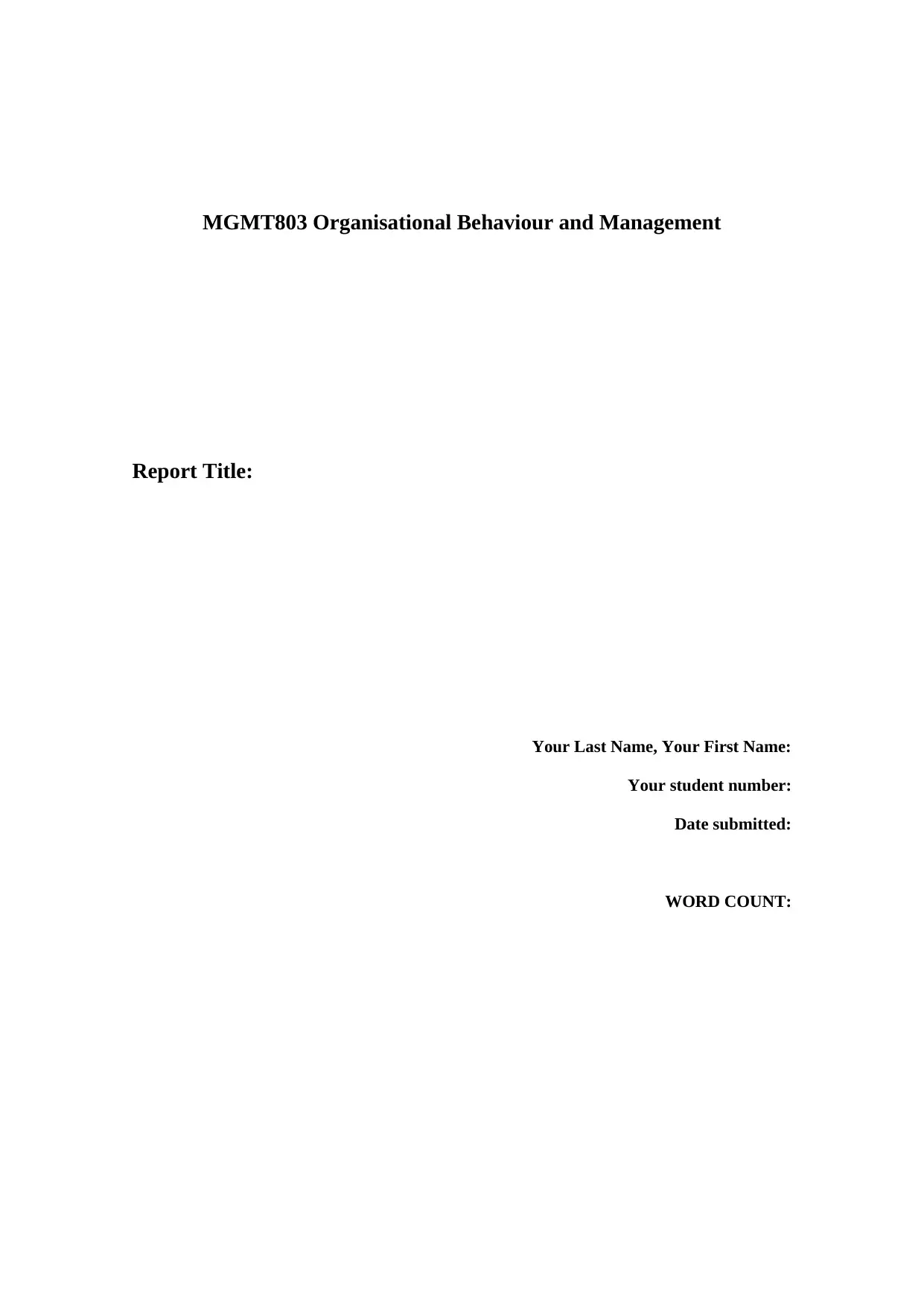
MGMT803 Organisational Behaviour and Management
Report Title:
Your Last Name, Your First Name:
Your student number:
Date submitted:
WORD COUNT:
Report Title:
Your Last Name, Your First Name:
Your student number:
Date submitted:
WORD COUNT:
Paraphrase This Document
Need a fresh take? Get an instant paraphrase of this document with our AI Paraphraser
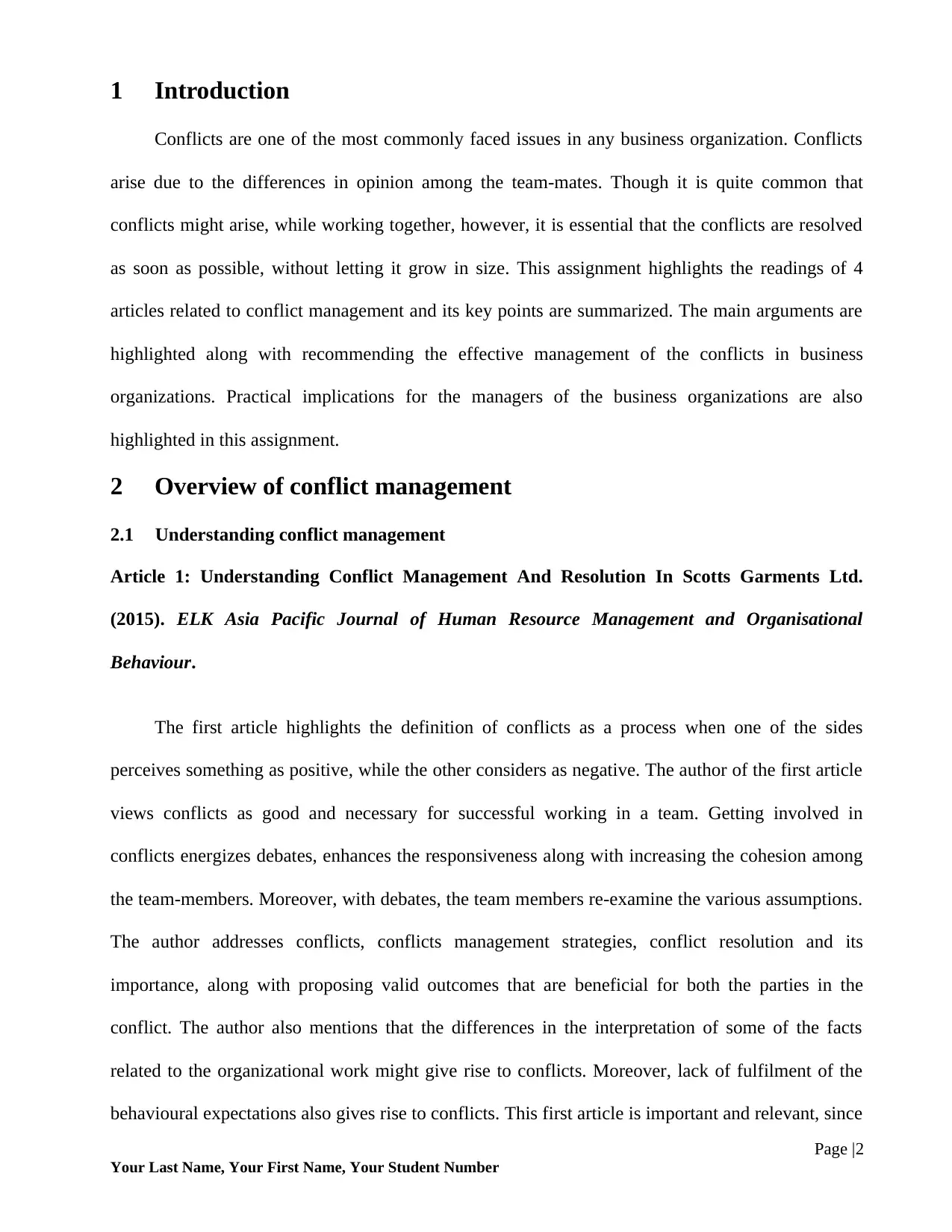
1 Introduction
Conflicts are one of the most commonly faced issues in any business organization. Conflicts
arise due to the differences in opinion among the team-mates. Though it is quite common that
conflicts might arise, while working together, however, it is essential that the conflicts are resolved
as soon as possible, without letting it grow in size. This assignment highlights the readings of 4
articles related to conflict management and its key points are summarized. The main arguments are
highlighted along with recommending the effective management of the conflicts in business
organizations. Practical implications for the managers of the business organizations are also
highlighted in this assignment.
2 Overview of conflict management
2.1 Understanding conflict management
Article 1: Understanding Conflict Management And Resolution In Scotts Garments Ltd.
(2015). ELK Asia Pacific Journal of Human Resource Management and Organisational
Behaviour.
The first article highlights the definition of conflicts as a process when one of the sides
perceives something as positive, while the other considers as negative. The author of the first article
views conflicts as good and necessary for successful working in a team. Getting involved in
conflicts energizes debates, enhances the responsiveness along with increasing the cohesion among
the team-members. Moreover, with debates, the team members re-examine the various assumptions.
The author addresses conflicts, conflicts management strategies, conflict resolution and its
importance, along with proposing valid outcomes that are beneficial for both the parties in the
conflict. The author also mentions that the differences in the interpretation of some of the facts
related to the organizational work might give rise to conflicts. Moreover, lack of fulfilment of the
behavioural expectations also gives rise to conflicts. This first article is important and relevant, since
Page |2
Your Last Name, Your First Name, Your Student Number
Conflicts are one of the most commonly faced issues in any business organization. Conflicts
arise due to the differences in opinion among the team-mates. Though it is quite common that
conflicts might arise, while working together, however, it is essential that the conflicts are resolved
as soon as possible, without letting it grow in size. This assignment highlights the readings of 4
articles related to conflict management and its key points are summarized. The main arguments are
highlighted along with recommending the effective management of the conflicts in business
organizations. Practical implications for the managers of the business organizations are also
highlighted in this assignment.
2 Overview of conflict management
2.1 Understanding conflict management
Article 1: Understanding Conflict Management And Resolution In Scotts Garments Ltd.
(2015). ELK Asia Pacific Journal of Human Resource Management and Organisational
Behaviour.
The first article highlights the definition of conflicts as a process when one of the sides
perceives something as positive, while the other considers as negative. The author of the first article
views conflicts as good and necessary for successful working in a team. Getting involved in
conflicts energizes debates, enhances the responsiveness along with increasing the cohesion among
the team-members. Moreover, with debates, the team members re-examine the various assumptions.
The author addresses conflicts, conflicts management strategies, conflict resolution and its
importance, along with proposing valid outcomes that are beneficial for both the parties in the
conflict. The author also mentions that the differences in the interpretation of some of the facts
related to the organizational work might give rise to conflicts. Moreover, lack of fulfilment of the
behavioural expectations also gives rise to conflicts. This first article is important and relevant, since
Page |2
Your Last Name, Your First Name, Your Student Number

it offers various ways of resolving conflicts. Some of the types suggested by the author includes
taking into consideration the interest of the other party, collaboration, compromising one’s interest
in order to resolve conflicts. However, the paper fails to address the destructive form of conflicts.
The ways of mitigation of the various types of conflicts occurring in any organization is useful for
ensuring that the conflicts are resolved as soon as they occur. Since the author highlights on the
constructive forms of conflicts, hence the article is important in discussing the benefits that conflicts
might bring to the business organizations. The article also highlights the fact that people need to
focus on discussion, along with respecting the interest of other parties.
Article 2: Tjosvold, D., Wong, A. and Feng Chen, N. (2014). Constructively Managing
Conflicts in Organizations. Annual Review of Organizational Psychology and Organizational
Behavior, 1(1), pp.545-568. Available at:
https://www.researchgate.net/publication/261181240_Constructively_Managing_Conflicts_in_
Organizations?enrichId=rgreq-e92a038c-a13b-46bb-9589-
625c478c5f76&enrichSource=Y292ZXJQYWdlOzI2MTE4MTI0MDtBUzo5OTYxMDEzNTY
yOTgyNUAxNDAwNzYwMzE1MTE5&el=1_x_3
The author of the second article suggests various constructive ways of managing conflicts in
any business organization. The author highlights that providing free expression of one’s point of
view is also essential in directing conflicts in a positive direction. Moreover, the author clearly
indicates the mutual benefits that are obtained from conflicts. The author also highlights various
skills and expertise that are required for the managers to fulfil the organizational goals, along with
dealing with organizational conflicts. Team-work has a key role to play in fulfilling the
organizational goals. The literature review amplifies the need for team-work in an organization,
along with highlighting how team-work could be effectively used by resolution of conflicts as soon
as possible. Various frameworks are models have been established such that conflict management
Page |3
Your Last Name, Your First Name, Your Student Number
taking into consideration the interest of the other party, collaboration, compromising one’s interest
in order to resolve conflicts. However, the paper fails to address the destructive form of conflicts.
The ways of mitigation of the various types of conflicts occurring in any organization is useful for
ensuring that the conflicts are resolved as soon as they occur. Since the author highlights on the
constructive forms of conflicts, hence the article is important in discussing the benefits that conflicts
might bring to the business organizations. The article also highlights the fact that people need to
focus on discussion, along with respecting the interest of other parties.
Article 2: Tjosvold, D., Wong, A. and Feng Chen, N. (2014). Constructively Managing
Conflicts in Organizations. Annual Review of Organizational Psychology and Organizational
Behavior, 1(1), pp.545-568. Available at:
https://www.researchgate.net/publication/261181240_Constructively_Managing_Conflicts_in_
Organizations?enrichId=rgreq-e92a038c-a13b-46bb-9589-
625c478c5f76&enrichSource=Y292ZXJQYWdlOzI2MTE4MTI0MDtBUzo5OTYxMDEzNTY
yOTgyNUAxNDAwNzYwMzE1MTE5&el=1_x_3
The author of the second article suggests various constructive ways of managing conflicts in
any business organization. The author highlights that providing free expression of one’s point of
view is also essential in directing conflicts in a positive direction. Moreover, the author clearly
indicates the mutual benefits that are obtained from conflicts. The author also highlights various
skills and expertise that are required for the managers to fulfil the organizational goals, along with
dealing with organizational conflicts. Team-work has a key role to play in fulfilling the
organizational goals. The literature review amplifies the need for team-work in an organization,
along with highlighting how team-work could be effectively used by resolution of conflicts as soon
as possible. Various frameworks are models have been established such that conflict management
Page |3
Your Last Name, Your First Name, Your Student Number
⊘ This is a preview!⊘
Do you want full access?
Subscribe today to unlock all pages.

Trusted by 1+ million students worldwide
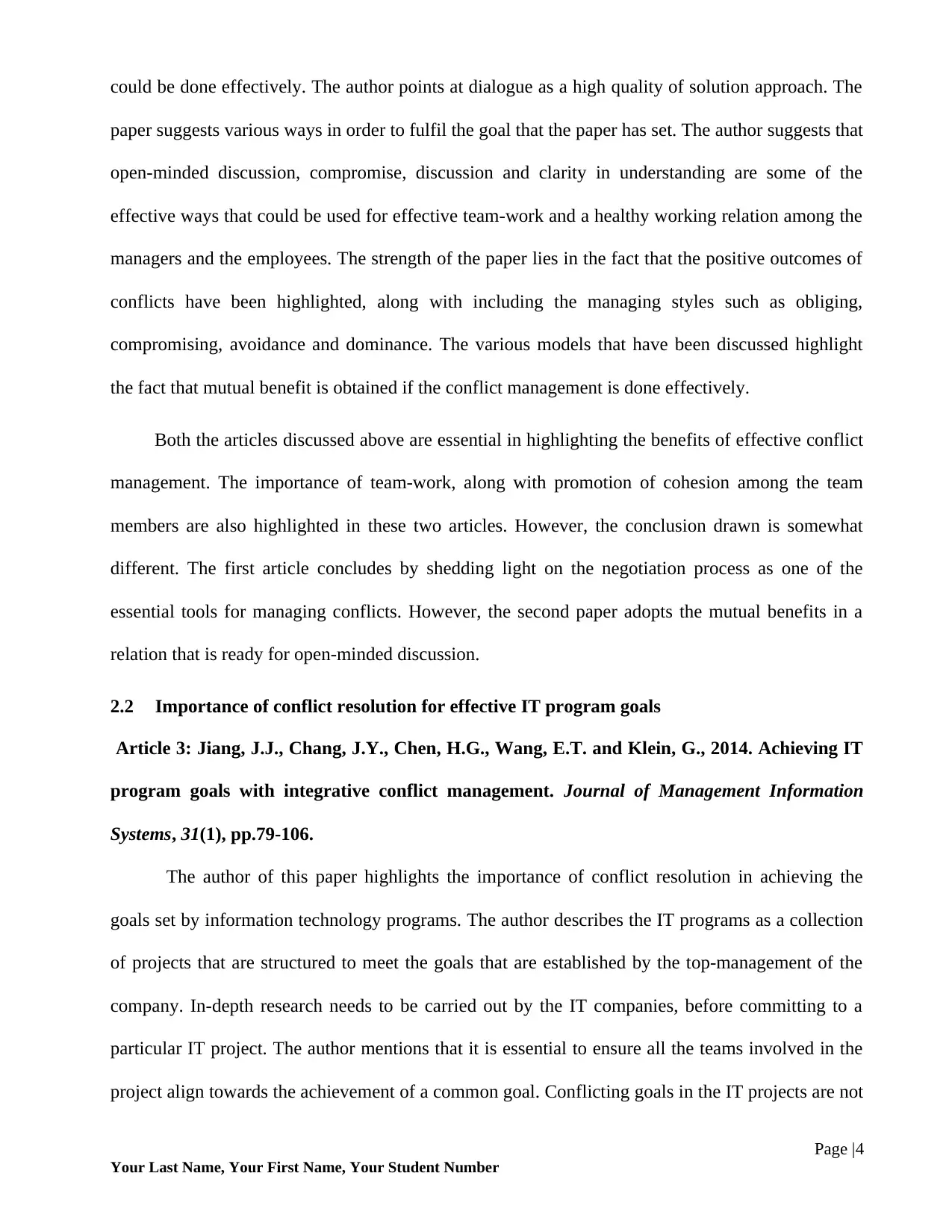
could be done effectively. The author points at dialogue as a high quality of solution approach. The
paper suggests various ways in order to fulfil the goal that the paper has set. The author suggests that
open-minded discussion, compromise, discussion and clarity in understanding are some of the
effective ways that could be used for effective team-work and a healthy working relation among the
managers and the employees. The strength of the paper lies in the fact that the positive outcomes of
conflicts have been highlighted, along with including the managing styles such as obliging,
compromising, avoidance and dominance. The various models that have been discussed highlight
the fact that mutual benefit is obtained if the conflict management is done effectively.
Both the articles discussed above are essential in highlighting the benefits of effective conflict
management. The importance of team-work, along with promotion of cohesion among the team
members are also highlighted in these two articles. However, the conclusion drawn is somewhat
different. The first article concludes by shedding light on the negotiation process as one of the
essential tools for managing conflicts. However, the second paper adopts the mutual benefits in a
relation that is ready for open-minded discussion.
2.2 Importance of conflict resolution for effective IT program goals
Article 3: Jiang, J.J., Chang, J.Y., Chen, H.G., Wang, E.T. and Klein, G., 2014. Achieving IT
program goals with integrative conflict management. Journal of Management Information
Systems, 31(1), pp.79-106.
The author of this paper highlights the importance of conflict resolution in achieving the
goals set by information technology programs. The author describes the IT programs as a collection
of projects that are structured to meet the goals that are established by the top-management of the
company. In-depth research needs to be carried out by the IT companies, before committing to a
particular IT project. The author mentions that it is essential to ensure all the teams involved in the
project align towards the achievement of a common goal. Conflicting goals in the IT projects are not
Page |4
Your Last Name, Your First Name, Your Student Number
paper suggests various ways in order to fulfil the goal that the paper has set. The author suggests that
open-minded discussion, compromise, discussion and clarity in understanding are some of the
effective ways that could be used for effective team-work and a healthy working relation among the
managers and the employees. The strength of the paper lies in the fact that the positive outcomes of
conflicts have been highlighted, along with including the managing styles such as obliging,
compromising, avoidance and dominance. The various models that have been discussed highlight
the fact that mutual benefit is obtained if the conflict management is done effectively.
Both the articles discussed above are essential in highlighting the benefits of effective conflict
management. The importance of team-work, along with promotion of cohesion among the team
members are also highlighted in these two articles. However, the conclusion drawn is somewhat
different. The first article concludes by shedding light on the negotiation process as one of the
essential tools for managing conflicts. However, the second paper adopts the mutual benefits in a
relation that is ready for open-minded discussion.
2.2 Importance of conflict resolution for effective IT program goals
Article 3: Jiang, J.J., Chang, J.Y., Chen, H.G., Wang, E.T. and Klein, G., 2014. Achieving IT
program goals with integrative conflict management. Journal of Management Information
Systems, 31(1), pp.79-106.
The author of this paper highlights the importance of conflict resolution in achieving the
goals set by information technology programs. The author describes the IT programs as a collection
of projects that are structured to meet the goals that are established by the top-management of the
company. In-depth research needs to be carried out by the IT companies, before committing to a
particular IT project. The author mentions that it is essential to ensure all the teams involved in the
project align towards the achievement of a common goal. Conflicting goals in the IT projects are not
Page |4
Your Last Name, Your First Name, Your Student Number
Paraphrase This Document
Need a fresh take? Get an instant paraphrase of this document with our AI Paraphraser

desirable. However, conflicts occur among the various teams, working in one particular project.
Each team often feels that the solution proposed by them is the best, and the other teams should
follow those. These conflicts need to be resolved such that the best IT program, collecting the
suggestions of all the teams could be provided to the client. The author proposes the use of the
integrative conflict management tool (ICM) for mitigating the conflicts. This technique is effective
in resolving the conflicts that occur among the various teams. Using these tools, the conflicts could
be resolved, this achieving better organizational goals.
The ICM model is important in the resolution of the conflicts of the IT teams and has
effective result in ensuring that the attainment of the goals is done successfully. The author also
concludes that conflict resolution is essential for ensuring that the key components of the programs
are utilized to meet the goals successfully. One limitation of this paper is the lack of highlighting the
positive impacts of conflicts, such as coherence among the employees, openness to suggestions. The
negative effects of conflicts and lack of its management has been shed light upon in this assignment.
2.3 Conflict management
Article 4: Thakore, D., 2013. Conflict and Conflict Management. IOSR Journal of Business
and Management (IOSR-JBM), 8(6). Available at:
http://iosrjournals.org/iosr-jbm/papers/Vol8-issue6/B0860716.pdf
This article highlights the fact that conflicts cannot be avoided, since it forms an integral part
of team-work. However, better management of the conflicts could be carried out successfully with
effective discussion, compromise and understanding. The author defines conflicts as disagreement
between two or more people, unable to accept the views of each other. The author defines the
transition in the view of conflicts with time. These include the traditional school view of conflicts,
human relation school view of conflicts, the inter-actionist school view of conflicts, the
Integrationist school view of conflict. The author also described the various forms of conflicts in an
organization. These include the interpersonal and intrapersonal conflicts, intergroup and intra-group
Page |5
Your Last Name, Your First Name, Your Student Number
Each team often feels that the solution proposed by them is the best, and the other teams should
follow those. These conflicts need to be resolved such that the best IT program, collecting the
suggestions of all the teams could be provided to the client. The author proposes the use of the
integrative conflict management tool (ICM) for mitigating the conflicts. This technique is effective
in resolving the conflicts that occur among the various teams. Using these tools, the conflicts could
be resolved, this achieving better organizational goals.
The ICM model is important in the resolution of the conflicts of the IT teams and has
effective result in ensuring that the attainment of the goals is done successfully. The author also
concludes that conflict resolution is essential for ensuring that the key components of the programs
are utilized to meet the goals successfully. One limitation of this paper is the lack of highlighting the
positive impacts of conflicts, such as coherence among the employees, openness to suggestions. The
negative effects of conflicts and lack of its management has been shed light upon in this assignment.
2.3 Conflict management
Article 4: Thakore, D., 2013. Conflict and Conflict Management. IOSR Journal of Business
and Management (IOSR-JBM), 8(6). Available at:
http://iosrjournals.org/iosr-jbm/papers/Vol8-issue6/B0860716.pdf
This article highlights the fact that conflicts cannot be avoided, since it forms an integral part
of team-work. However, better management of the conflicts could be carried out successfully with
effective discussion, compromise and understanding. The author defines conflicts as disagreement
between two or more people, unable to accept the views of each other. The author defines the
transition in the view of conflicts with time. These include the traditional school view of conflicts,
human relation school view of conflicts, the inter-actionist school view of conflicts, the
Integrationist school view of conflict. The author also described the various forms of conflicts in an
organization. These include the interpersonal and intrapersonal conflicts, intergroup and intra-group
Page |5
Your Last Name, Your First Name, Your Student Number

conflicts, inter-organizational conflicts. However, it is essential that all these types of conflicts be
resolved as soon as possible. The author has described a conflict resolution model that describes the
various steps of resolving the conflicts successfully. The various strategies that could be taken up in
order to ensure successful resolution of the conflicts include achievement of personal goals, keeping
good relation with others. Moreover, it is important that people avoid the rise of conflicts. This is
also an effective strategy, to ensure effective conflict resolution. Smoothing is another effective
strategy that could be used in conflict resolution. Smoothing refers to the conciliation that takes
place, when one person is ready to accept the opinion of the other. Forcing is also another way of
conflict resolution that results in forcing a person to accept the view point of the other. The author
concludes that conflict is an omnipresent feature of every organization. However, since all teams
and units are part of the same organization, hence conflicts have to be resolved as soon as possible.
2.4 Summary of key points from literature
Each of the four articles that are summarized in the above sections highlight a common goal of
successful resolution of conflicts. The first and the second articles highlight the positive impacts of
conflicts. These include the openness of decisions, exploration of various other options, clarity in
communication, and increased sense of coherence among the employees. However, the other two
articles highlight the various ways conflicts could be resolved successfully. The strategies that
could be used in order to resolve the conflicts successfully includes conciliation, consultation,
arbitration, mediation, confrontation, forcing, smoothing, avoidance, as well as ensuring positive
relation among the employees.
3 Practical implications for managers
The managers could benefit from the conflict resolution skills that are discussed in the above-
mentioned four articles. Conflicts are common in any business organization. The managers have to
be skilled enough to ensure the successful conflict management. The managers need to have the
Page |6
Your Last Name, Your First Name, Your Student Number
resolved as soon as possible. The author has described a conflict resolution model that describes the
various steps of resolving the conflicts successfully. The various strategies that could be taken up in
order to ensure successful resolution of the conflicts include achievement of personal goals, keeping
good relation with others. Moreover, it is important that people avoid the rise of conflicts. This is
also an effective strategy, to ensure effective conflict resolution. Smoothing is another effective
strategy that could be used in conflict resolution. Smoothing refers to the conciliation that takes
place, when one person is ready to accept the opinion of the other. Forcing is also another way of
conflict resolution that results in forcing a person to accept the view point of the other. The author
concludes that conflict is an omnipresent feature of every organization. However, since all teams
and units are part of the same organization, hence conflicts have to be resolved as soon as possible.
2.4 Summary of key points from literature
Each of the four articles that are summarized in the above sections highlight a common goal of
successful resolution of conflicts. The first and the second articles highlight the positive impacts of
conflicts. These include the openness of decisions, exploration of various other options, clarity in
communication, and increased sense of coherence among the employees. However, the other two
articles highlight the various ways conflicts could be resolved successfully. The strategies that
could be used in order to resolve the conflicts successfully includes conciliation, consultation,
arbitration, mediation, confrontation, forcing, smoothing, avoidance, as well as ensuring positive
relation among the employees.
3 Practical implications for managers
The managers could benefit from the conflict resolution skills that are discussed in the above-
mentioned four articles. Conflicts are common in any business organization. The managers have to
be skilled enough to ensure the successful conflict management. The managers need to have the
Page |6
Your Last Name, Your First Name, Your Student Number
⊘ This is a preview!⊘
Do you want full access?
Subscribe today to unlock all pages.

Trusted by 1+ million students worldwide
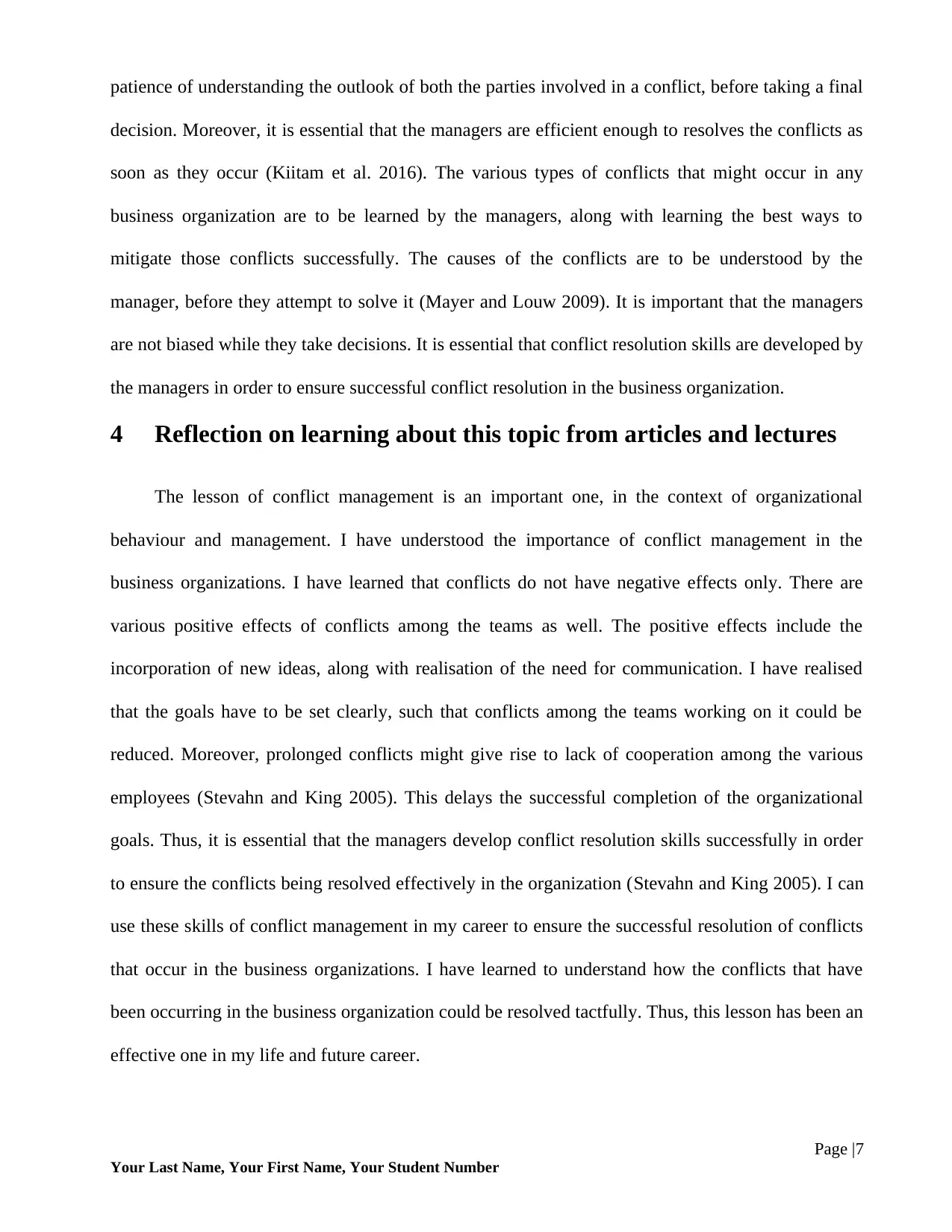
patience of understanding the outlook of both the parties involved in a conflict, before taking a final
decision. Moreover, it is essential that the managers are efficient enough to resolves the conflicts as
soon as they occur (Kiitam et al. 2016). The various types of conflicts that might occur in any
business organization are to be learned by the managers, along with learning the best ways to
mitigate those conflicts successfully. The causes of the conflicts are to be understood by the
manager, before they attempt to solve it (Mayer and Louw 2009). It is important that the managers
are not biased while they take decisions. It is essential that conflict resolution skills are developed by
the managers in order to ensure successful conflict resolution in the business organization.
4 Reflection on learning about this topic from articles and lectures
The lesson of conflict management is an important one, in the context of organizational
behaviour and management. I have understood the importance of conflict management in the
business organizations. I have learned that conflicts do not have negative effects only. There are
various positive effects of conflicts among the teams as well. The positive effects include the
incorporation of new ideas, along with realisation of the need for communication. I have realised
that the goals have to be set clearly, such that conflicts among the teams working on it could be
reduced. Moreover, prolonged conflicts might give rise to lack of cooperation among the various
employees (Stevahn and King 2005). This delays the successful completion of the organizational
goals. Thus, it is essential that the managers develop conflict resolution skills successfully in order
to ensure the conflicts being resolved effectively in the organization (Stevahn and King 2005). I can
use these skills of conflict management in my career to ensure the successful resolution of conflicts
that occur in the business organizations. I have learned to understand how the conflicts that have
been occurring in the business organization could be resolved tactfully. Thus, this lesson has been an
effective one in my life and future career.
Page |7
Your Last Name, Your First Name, Your Student Number
decision. Moreover, it is essential that the managers are efficient enough to resolves the conflicts as
soon as they occur (Kiitam et al. 2016). The various types of conflicts that might occur in any
business organization are to be learned by the managers, along with learning the best ways to
mitigate those conflicts successfully. The causes of the conflicts are to be understood by the
manager, before they attempt to solve it (Mayer and Louw 2009). It is important that the managers
are not biased while they take decisions. It is essential that conflict resolution skills are developed by
the managers in order to ensure successful conflict resolution in the business organization.
4 Reflection on learning about this topic from articles and lectures
The lesson of conflict management is an important one, in the context of organizational
behaviour and management. I have understood the importance of conflict management in the
business organizations. I have learned that conflicts do not have negative effects only. There are
various positive effects of conflicts among the teams as well. The positive effects include the
incorporation of new ideas, along with realisation of the need for communication. I have realised
that the goals have to be set clearly, such that conflicts among the teams working on it could be
reduced. Moreover, prolonged conflicts might give rise to lack of cooperation among the various
employees (Stevahn and King 2005). This delays the successful completion of the organizational
goals. Thus, it is essential that the managers develop conflict resolution skills successfully in order
to ensure the conflicts being resolved effectively in the organization (Stevahn and King 2005). I can
use these skills of conflict management in my career to ensure the successful resolution of conflicts
that occur in the business organizations. I have learned to understand how the conflicts that have
been occurring in the business organization could be resolved tactfully. Thus, this lesson has been an
effective one in my life and future career.
Page |7
Your Last Name, Your First Name, Your Student Number
Paraphrase This Document
Need a fresh take? Get an instant paraphrase of this document with our AI Paraphraser
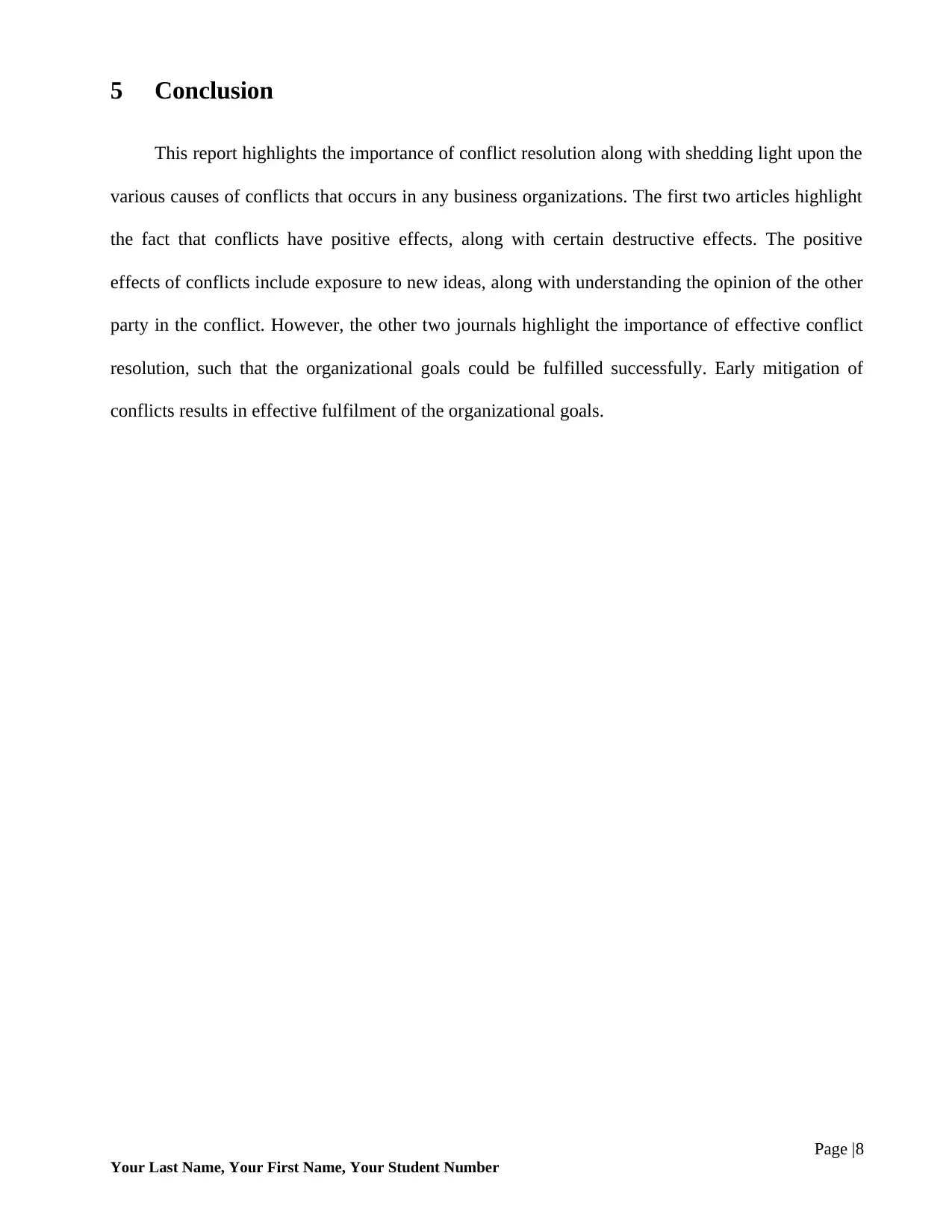
5 Conclusion
This report highlights the importance of conflict resolution along with shedding light upon the
various causes of conflicts that occurs in any business organizations. The first two articles highlight
the fact that conflicts have positive effects, along with certain destructive effects. The positive
effects of conflicts include exposure to new ideas, along with understanding the opinion of the other
party in the conflict. However, the other two journals highlight the importance of effective conflict
resolution, such that the organizational goals could be fulfilled successfully. Early mitigation of
conflicts results in effective fulfilment of the organizational goals.
Page |8
Your Last Name, Your First Name, Your Student Number
This report highlights the importance of conflict resolution along with shedding light upon the
various causes of conflicts that occurs in any business organizations. The first two articles highlight
the fact that conflicts have positive effects, along with certain destructive effects. The positive
effects of conflicts include exposure to new ideas, along with understanding the opinion of the other
party in the conflict. However, the other two journals highlight the importance of effective conflict
resolution, such that the organizational goals could be fulfilled successfully. Early mitigation of
conflicts results in effective fulfilment of the organizational goals.
Page |8
Your Last Name, Your First Name, Your Student Number
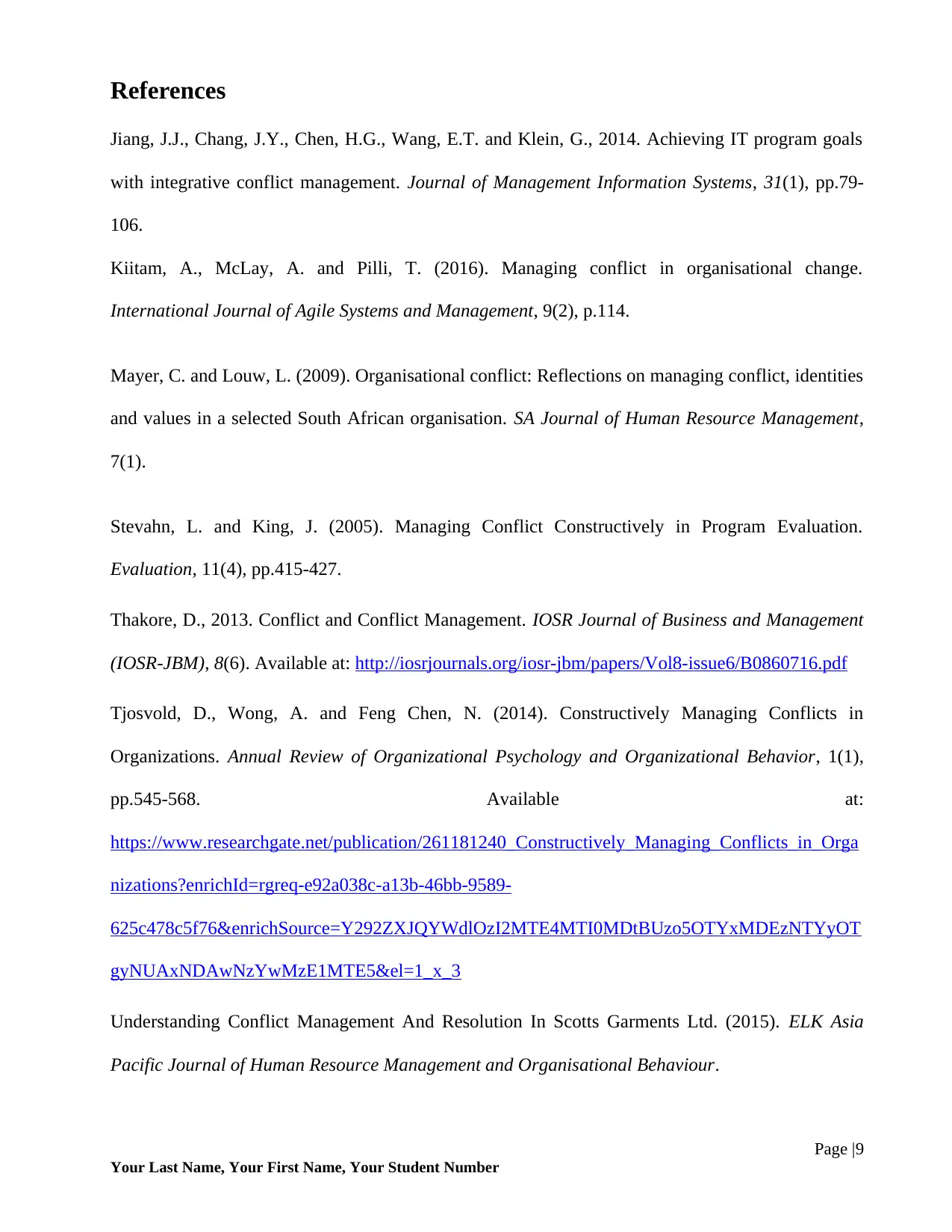
References
Jiang, J.J., Chang, J.Y., Chen, H.G., Wang, E.T. and Klein, G., 2014. Achieving IT program goals
with integrative conflict management. Journal of Management Information Systems, 31(1), pp.79-
106.
Kiitam, A., McLay, A. and Pilli, T. (2016). Managing conflict in organisational change.
International Journal of Agile Systems and Management, 9(2), p.114.
Mayer, C. and Louw, L. (2009). Organisational conflict: Reflections on managing conflict, identities
and values in a selected South African organisation. SA Journal of Human Resource Management,
7(1).
Stevahn, L. and King, J. (2005). Managing Conflict Constructively in Program Evaluation.
Evaluation, 11(4), pp.415-427.
Thakore, D., 2013. Conflict and Conflict Management. IOSR Journal of Business and Management
(IOSR-JBM), 8(6). Available at: http://iosrjournals.org/iosr-jbm/papers/Vol8-issue6/B0860716.pdf
Tjosvold, D., Wong, A. and Feng Chen, N. (2014). Constructively Managing Conflicts in
Organizations. Annual Review of Organizational Psychology and Organizational Behavior, 1(1),
pp.545-568. Available at:
https://www.researchgate.net/publication/261181240_Constructively_Managing_Conflicts_in_Orga
nizations?enrichId=rgreq-e92a038c-a13b-46bb-9589-
625c478c5f76&enrichSource=Y292ZXJQYWdlOzI2MTE4MTI0MDtBUzo5OTYxMDEzNTYyOT
gyNUAxNDAwNzYwMzE1MTE5&el=1_x_3
Understanding Conflict Management And Resolution In Scotts Garments Ltd. (2015). ELK Asia
Pacific Journal of Human Resource Management and Organisational Behaviour.
Page |9
Your Last Name, Your First Name, Your Student Number
Jiang, J.J., Chang, J.Y., Chen, H.G., Wang, E.T. and Klein, G., 2014. Achieving IT program goals
with integrative conflict management. Journal of Management Information Systems, 31(1), pp.79-
106.
Kiitam, A., McLay, A. and Pilli, T. (2016). Managing conflict in organisational change.
International Journal of Agile Systems and Management, 9(2), p.114.
Mayer, C. and Louw, L. (2009). Organisational conflict: Reflections on managing conflict, identities
and values in a selected South African organisation. SA Journal of Human Resource Management,
7(1).
Stevahn, L. and King, J. (2005). Managing Conflict Constructively in Program Evaluation.
Evaluation, 11(4), pp.415-427.
Thakore, D., 2013. Conflict and Conflict Management. IOSR Journal of Business and Management
(IOSR-JBM), 8(6). Available at: http://iosrjournals.org/iosr-jbm/papers/Vol8-issue6/B0860716.pdf
Tjosvold, D., Wong, A. and Feng Chen, N. (2014). Constructively Managing Conflicts in
Organizations. Annual Review of Organizational Psychology and Organizational Behavior, 1(1),
pp.545-568. Available at:
https://www.researchgate.net/publication/261181240_Constructively_Managing_Conflicts_in_Orga
nizations?enrichId=rgreq-e92a038c-a13b-46bb-9589-
625c478c5f76&enrichSource=Y292ZXJQYWdlOzI2MTE4MTI0MDtBUzo5OTYxMDEzNTYyOT
gyNUAxNDAwNzYwMzE1MTE5&el=1_x_3
Understanding Conflict Management And Resolution In Scotts Garments Ltd. (2015). ELK Asia
Pacific Journal of Human Resource Management and Organisational Behaviour.
Page |9
Your Last Name, Your First Name, Your Student Number
⊘ This is a preview!⊘
Do you want full access?
Subscribe today to unlock all pages.

Trusted by 1+ million students worldwide
1 out of 9
Related Documents
Your All-in-One AI-Powered Toolkit for Academic Success.
+13062052269
info@desklib.com
Available 24*7 on WhatsApp / Email
![[object Object]](/_next/static/media/star-bottom.7253800d.svg)
Unlock your academic potential
Copyright © 2020–2025 A2Z Services. All Rights Reserved. Developed and managed by ZUCOL.





